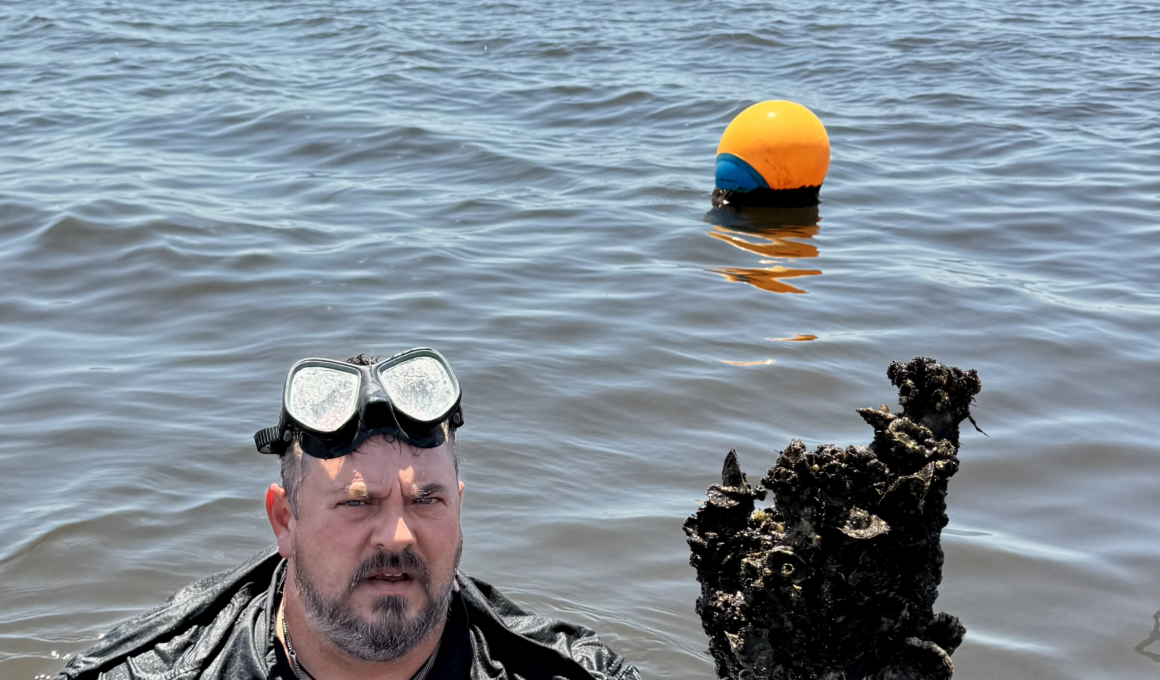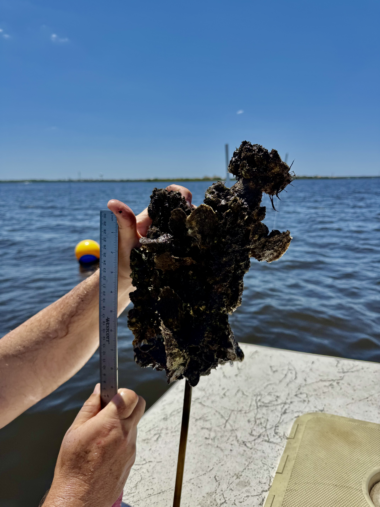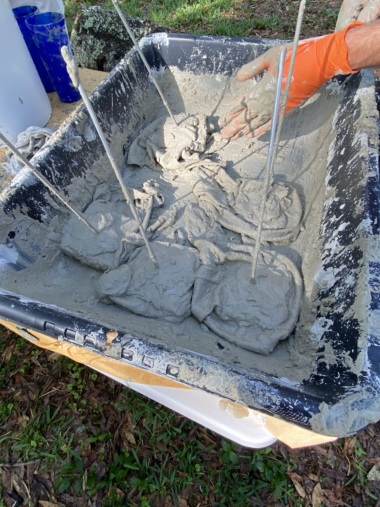Restoring the Manatee River, One Oyster Reef Pot at a Time

May 10, 2025
By Vicki Parsons
At 370 days, two- and three-inch oysters coated one of the first ORPs placed in the Manatee River. All photos courtesty Oyster River Ecology.

Damon Moore is known for setting audacious goals. His first was a self-described “hair-brained scheme” to restore Mariposa Key. Then, working as a restoration ecologist for Manatee County, he directed the transformation of what had been 150 acres of abandoned farmland to low-salinity habitats specifically created to support snook at Robinson Preserve. Now, as founder of the non-profit Oyster River Ecology (ORE), Moore is hoping to restore more than 100 acres of subtidal oyster habitat in the Manatee River — one ORP at a time.
Oyster reefs are considered critical habitat because a single oyster can filter up to 50 gallons of water every day, and they provide food and shelter for small fish and crustaceans. The Tampa Bay Estuary Program’s Habitat Restoration Master Plan calls for nearly tripling the acreage of oyster reefs found in the bay by the year 2050.

ORPs, aka oyster rag pots, were designed to help meet that goal. They are modeled after a popular online trend where people make flower pots using wet concrete hung over various shapes. Tinkering in his backyard, Moore took that concept and used garage rags dipped in concrete and hung over four-inch wood spacers. The first ORPs were placed last summer along with several other prototypes.
“There are still sweet spots in the Manatee River where subtidal oysters grow. There is plenty of food for oysters but they are not under constant predation pressire,” Moore said. “We know they’re out there because we’ll find things like shopping carts and derelict crab traps that are covered in healthy oysters. Oysters can thrive in these areas if they have the substrate to grow on.”
Multiple options for substrate are available, from shells collected from nearby restaurants to sophisticated 3-D printed modules and from rocky riprap to highly engineered oyster balls, he said. “The first thing you notice with all those options is that they’re very heavy and use a lot of material. My goal was to maximize the surface area for oysters to grow with minimal materials and cost.”
The least expensive option, widely used option is riprap but that could cost upwards of $600,000 an acre – not an option when the goal is over 100 acres. “We need to create something cheaper than rocks,” he quips.
ORPs, which cost about $1.20 each in materials and another $4 to manufacture and place, could be the answer. Moore obtained the necessary permits for a group of volunteers to place ORPs along with other prototypical substrates in the Manatee River last year to see which option worked best. “The oysters really took to the ORPs,” he said. “We had spat (oyster larvae) within a month and at 370 days, they were caked with two- or three-inch oysters even though they had a tough time last summer.”
The two hurricanes that swept through the region dumped so much rain that the Manatee River was basically freshwater for two weeks. Although it killed some of the oysters, those growing on the ORPs recovered. “You could see the damage right after the hurricanes, but when I went back a couple of months later, the dead oysters had all sloughed off and the original oysters were still there and growing,” he said. “I guess they were larger and could handle that much freshwater better.”
While ORPs are cost-effective and eye-catching, Moore stresses that their success in that particular stretch of river– the Goldilocks zone, he calls it– is the result of years of research and observation to find those sweet spots. “The unsung part of this story is that you have to have them at the right site where the right oysters are going to want to grow subtidally. Seeing crab traps covered in oysters just led me to the idea that if we just provide the framework, then the oysters, known as ecosystem engineers, will do the hard work on their own and continue to create new reefs.”

RE has already installed ORPs on over 500 square feet of a 10-acre approved site near Colony Cove in Ellenton. “If we put them on one-foot centers, and they do as well as they did in the test plots, in about 18 to 24 months, they’ll start to coalesce and grow into each other. There already are thousands of ORPs out there, and we’re getting better at building and placing them as we go along.”
Community groups from Boy Scouts to senior citizens have come together to build the ORPs and Moore developed an ingenious method to transport the fragile objects that don’t stack well from the building site to the restoration area, and then to anchor them in the silty river bottom. “We learned a lot working with Pinellas County on their living shoreline at Philippe Park, and we’re hoping to organize kayakers later this summer to help place ORPs in shallow nearshore waters,” he said.
Over time, ORE hopes to restore at least 100 but up to 300 subtidal acres, Moore adds. “We’re looking at maps of the Manatee River created by the Army Corps of Engineers in 1888 to determine where oysters had been found and how much of an area of oyster reef was there before the resource was impacted. We stitched that map over current aerials of the river and calculated that an impressive 132 acres had been lost.”
Restoration experts across the state in the Indian River Lagoon, and north to Apalachicola Bay, are also looking at using ORPs. “Word is getting out, and it’s really exciting to be working with other groups toward the same goals of achieving cost-effective large-scale oyster restoration.”
Learn more about ORPs and support ORE’s efforts to restore the Manatee River at the first-ever Oyster Rag Pot Shindig on May 22 at Palma Sola Botanical Park in Bradenton. For reservations, visit https://oysterriverecology.networkforgood.com/events/83592-oyster-rag-pot-shin-dig
